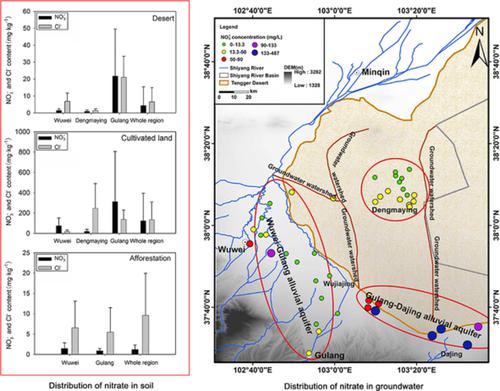当前位置:
X-MOL 学术
›
Hydrol. Process.
›
论文详情
Our official English website, www.x-mol.net, welcomes your feedback! (Note: you will need to create a separate account there.)
Soil NO3− storage from oasis development in deserts: Implications for the prevention and control of groundwater pollution
Hydrological Processes ( IF 3.2 ) Pub Date : 2020-07-20 , DOI: 10.1002/hyp.13855 Shi Qi 1 , Wei Liu 2 , Heping Shu 3 , Fei Liu 4 , Jinzhu Ma 5
Hydrological Processes ( IF 3.2 ) Pub Date : 2020-07-20 , DOI: 10.1002/hyp.13855 Shi Qi 1 , Wei Liu 2 , Heping Shu 3 , Fei Liu 4 , Jinzhu Ma 5
Affiliation

|
The sources and storage of soil NO3− in the western Tengger Desert, Northwest China, were explored using water chemistry analysis and stable isotope techniques. In line with the expansion and development of oases, part of the desert has been transformed into cultivated land and artificial forest land. The mean soil NO3− contents found in areas of cultivated land and artificial forest were 123.06 mg kg−1 and 1.26 mg kg−1, far higher and slightly lower than the background desert soil values, respectively. The δ15N‐NO3− and δ18O‐NO3− values in cultivated soils ranged from 1.00 to 11.81 ‰, and from −1.85 to 8.99 ‰, respectively, and the mean mNO3−/Cl− value in cultivated soils was 2.3. These figures would appear to demonstrate that the rapid increase in the nitrate content in soils is principally due to the use of nitrogen fertilizer. Such increases in soil NO3− storage is likely to promote the leaching of nitrogen into the groundwater where coarsely textured soils exist, the pollution of water sources used for irrigation water, and extreme precipitation events. The δ15N‐NO3− and δ18O‐NO3− values in groundwater ranged from 3.72 to 6.54 ‰, and from −0.19 to 12.06 ‰, respectively, mainly reflecting the nitrification of soil nitrogen. These values appeared similar to those measured in the soil water in adjacent areas of cultivated land and vegetated desert, indicating that the groundwater has been affected by both natural and artificial NO3−. Artificial afforestation of desert regions would therefore seem to be a useful way of reducing the threat posed by anthropogenic sources to the circulation of NO3−‐N within arid regions, as well as promoting wind sheltering and sand fixation. This study explored the NO3− storage and groundwater quality responses to oasis development in arid areas in an attempt to provide effective information for local agricultural organizations and agricultural nitrogen management models.
更新日期:2020-07-20



























 京公网安备 11010802027423号
京公网安备 11010802027423号